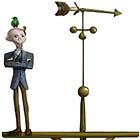She says, “I am content when wakened birds,
Before they fly, test the reality
Of misty fields, by their sweet questionings”
Here’s the scene: A street partially excavated, construction equipment scattered about, jackhammers and backup beepers striking a symphony of cacophony. But, lo, what do I behold rounding the corner? Could it be? Yes, a lone driver has decided, despite all the barricades and “Do Not Enter” signs, that this street is still an active thoroughfare. Even the seasoned construction workers shake their heads and tsk-tsk at such foolishness. This episode repeats all day and all night as drivers test the reality of a dead-end street.
For the past two years, the condition of my street has existed in a variety of states that can be best summarized by the phrase “torn-up.” We have been hostages to an ambitious sewer project aimed at safeguarding the nearby Hudson River. While I’m fully on board with the goals of the endeavor, the noise and disruptions try the limits of my patience.
In particular, for the past three months or so, my street has been completely closed to all but local traffic because the intersection by my house has been—you guessed it—torn-up. Despite the sign at the other end of the block that says “Road Closed, Local Traffic Only,” the three or four other signs that say “Do Not Enter,” and the evidence of a large and quite busy construction site, non-local vehicles continually traverse the closed street, hoping perhaps that a path will miraculously reveal itself and magically guide their car through the mayhem and toward its destination.
It’s like watching a dark comedy or an absurdist play: A vehicle pulls up the to the intersection at the other end of my block, it’s driver clearly perplexed by the array of “Do Not Enter” and “Road Closed” signs. Somehow, for this individual, these several notices do not offer sufficient warning, though. After a lengthy pause, the driver chooses to ignore the evidence assembled before them and turns onto my street, at times forced to weave among an assemblage of dump trucks, front-end loaders, and backhoes. My neighbors and I groan collectively at the spectacle as the driver ultimately encounters the dead-end and is reduced to executing a clumsy K-turn with the help of one of our driveways. This scene unfolds dozens of times a day.
So, what compels people who are intelligent enough to secure a driver’s license and operate a vehicle to motor down my obviously closed street? Do they distrust their own eyes? Are they radically anti-authority—sticking it to the man with their scofflaw ways? Or, perhaps it’s the opposite, that they feel compelled to submit mindlessly to their dictatorial navigation app barking orders to “turn right!”
There are still others, I’m sure, who—emboldened by their profound solipsism and sense of prerogative—are convinced that rules don’t apply to them, that even physical obstacles are only there to hinder the little people. Surely not them! Their behavior manifests a toxic cocktail of arrogance, ignorance, and fecklessness that is so prevalent that it needs a name. Maybe you’ve heard of “the dark triad”; let’s call this mélange of foolishness “the dumb triad.” Whatever the reason, though, the nonstop stream of wayward vehicles never ceases to vex me.
I know I’m being a little harsh. We all make mistakes even in the face of clear warning signs. But then, as I watch yet another lost soul amble down my dead-end street only to put their miserable K-turning ability to the test, it hits me: This bizarre ritual is a perfect analogy for how managers and leaders navigate decisions.
You didn’t see that coming, did you? Well, maybe you did.
Just as these silly drivers blow right past warning signs, fixated on the commands insistently streaming from their navigation app and heedless of the consequences, so too do many managers stubbornly stay on their predetermined course no matter the dangers, sacrifices, and outcomes. Pressure mounts from within and without to maintain an aura of steadfast confidence and decisiveness. Like our errant drivers, these bosses proceed to plunge themselves and their organizations onto a treacherous route that can only terminate in a dead end.
Better to stick to the plan and hope for the best than to rely on your wits and discernment to find an alternate route, right? Or so goes the thinking. This is the case with both headstrong and weak-willed bosses; the former are unwilling and the latter are unable to recalibrate and navigate the challenges before them.
And then there are the ones who imagine that the rules simply don’t apply to them, that by brazenly disregarding the "Road Closed" signs and masquerading as "local traffic" they can somehow pass through unscathed. I have seen this type pitching a fit in their vehicles when they reach the end of the road. Then, after demonstrating their scant driving abilities with yet another ungainly K-turn, they angrily blast back up the way they came as though recklessly speeding on a residential block will compensate for their frustration and foolishness.
Similarly, there are far too many managers who operate under the delusion that consequences are for others, that their decisions are infallible and any negative outcomes are the result of external forces or cosmic conspiracies. In their minds, they wield absolute authority and reap maximum rewards, yet bear no responsibility for their actions. It's a dangerous mindset, one that can lead to disastrous outcomes, both on the road and in the boardroom.
Psychologists have theorized that power itself can cause a form of brain damage, that titles and authority erode the basic ability to connect with other humans. This theory would explain the behavior of those bosses who seem incapable of heeding warning signs or acknowledging their own imperfections.
I wonder, though, if the mental affliction of power affects their driving. Does being intoxicated on dominance and privilege impair your ability to operate a vehicle? I have written on the dangers of BUI, bossing under the influence.
Could BUI be just as reckless on the road as it is in the workplace? Are some of these scofflaw drivers who come pouring down my street just power-besotted bosses late for their tee-time.
True leaders simply don’t behave like that. They have both the humility and adaptability to heed warning signs. I’m not saying they shrink from obstacles, but they possess the wisdom to recognize when a course correction is necessary. They aren’t afraid to reconsider, recalibrate, and even reverse course when warranted. Just about every option is in such a leader’s toolkit, except of course the foolhardy act of surging ahead into an obvious dead end. Leaders know when to quit, when to turn around, and when to consult a map—metaphorical or otherwise. They know when to stop digging and when to stop driving.
Maybe I’m flogging this metaphor a little too much, but the similarities between the feckless drivers who execute inept K-turns and the behavior of bad bosses are just too rich. Yes, maybe power does cause brain damage—a condition that manifests itself in boss after boss barreling down the closed streets of life, ignoring every warning sign and trusting their own hubris above all else. And when the inevitable reckoning comes, they'll find a way to blame the GPS, the city, the construction crew, or even their lying eyes—anything but them and their own evident ineptitude. Just like a boss.
So, next time you come upon a road closure or a leadership challenge, pause a bit to contemplate the lessons offered by the hapless drivers on my street. Maybe instead of just continuing forward, heed the warning signs, trust your eyes, and, above all, be willing to change course when necessary. Because in the end, the true measure of a leader isn't their unwavering adherence to a plan but their ability to navigate the unexpected pits, snags, and obstacles that life—and leadership—inevitably place in our way.
What do you do when you face obstacles? Do you ever stubbornly continue on when there is no place to go?
Great leaders learn how to heed warning signs so that they can overcome obstacles or recalibrate, and I can help.
Unlock the Great Leader Within! Download my free resource, the Transform To GREATness Toolkit, now!
I look forward to hearing from you.
Intro and outro podcast theme music by LiteSaturation from Pixabay.
If you want to invite me speak at your event or appear on your podcast, visit these pages for more information:


















Share this post